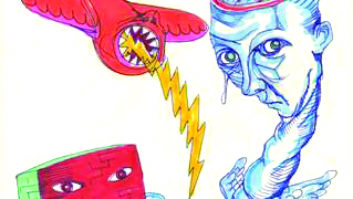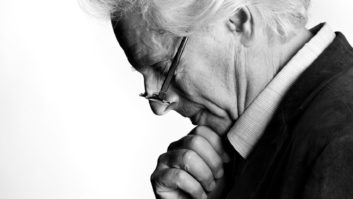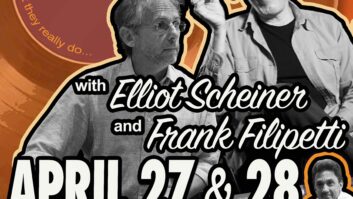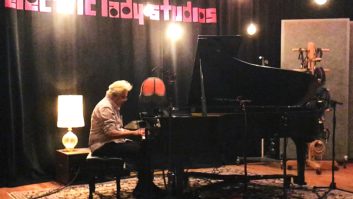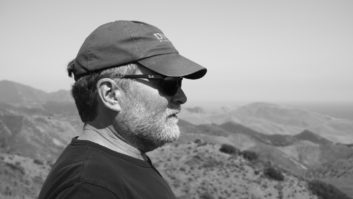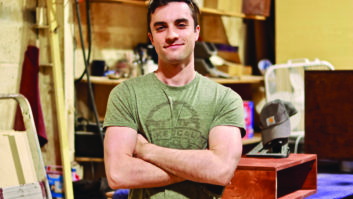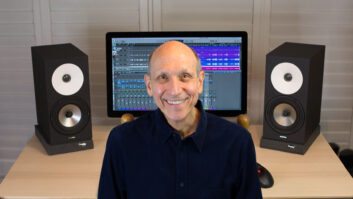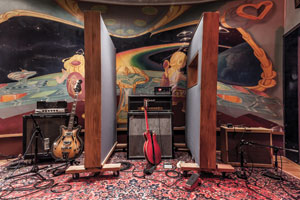
Photo : Brad Stein
You’d be hard-pressed to find a place anywhere in the world more inexorably connected with its founder than Electric Lady Studios. The name Jimi Hendrix is bound to come up, whether the conversation is about this iconic studio’s tomorrow, yesterday or today.
Lee Foster has been the General Manager of Electric Lady since 2004, and it seems that the heavenly approval of Hendrix is never far from his mind. “In general, I have to be thoughtful of, not only the day-to-day operations and clientele, but the history and future of an icon’s legacy as well,” he says. “I once asked a mentor for advice, and his response was a stern and simple, ‘Don’t f— up.’ It was the best advice I ever received.
“There has always been a bigger picture in my head,” Foster continues, “that goes something like this: ‘Someday someone will write a book about the studio, and the recordings made here on my watch need to be respectful and representative of Electric Lady’s legacy. Of Hendrix’s legacy.’ I can’t just book sessions to the highest bidder here, and/or ‘first come, first serve.’ I have a responsibility to curate my portion of the total legacy. It matters to me.”
Of course, a big part of preserving Hendrix’s legend means knowing when to be adventurous. For Foster and his team, that requires striking a balance between tradition and progress when equipping the John Storyk-designed studios, which first opened for business on August 26, 1970.
“I’m not a technical person, but I like classic things,” notes Foster. “The owner likes classic things. We believe in classic consoles, amplifiers, microphones and techniques. I balance it with the modern standards as they happen—software updates, plug-ins and mid-field monitoring options primarily.

The refurbished API 3288, in the newly constructed API Tracking Suite.
Photo : Brad Stein
“When renovating the facility in 2011 and 2012, for example, the owner and I decided that no two rooms would share an identical desk. We inherited three rooms with three SSL J9000s, which we felt was a mistake. Now, we have a classic, completely restored Neve 8078, a completely restored API 3288, Tom Elmhirst’s Neve VR, John O’Mahony’s Neve Genesys, and one remaining, custom purple SSL 9080 in Michael Brauer’s room. Each desk is ideal for its individual application and studio—we have every flavor.”
While things are humming along at a brisk pace at Electric Lady today, building up to this point took some concerted reconstruction. When Foster took over operations, he found that his client base had shrunk down too narrowly for comfort, a condition that he took methodical action to correct.
“Candidly, the early 2000s was a difficult period for all studios, Electric Lady included,” he explains. “I inherited a small, mostly hip hop-oriented clientele, but not much else. I maintained what was there and started building on it locally with East Village artists like Ryan Adams and The Strokes, and continued to expand our network from there. Over time, I was able to reintroduce the facility to Patti Smith, David Bowie and Keith Richards. More recently, I’ve seen Prince, Arcade Fire, U2, Adele and Daft Punk in our hallways. It’s nothing like it was nine years ago. Again, project diversity and performance matters here.”
According to Foster, upgrading the staffing and equipment have come first in accomplishing the critical mission of growing his client base. “You have to make the bed before you invite people over, and you have to find a team that supports the total vision. Once you’re ready, you introduce people to the product, and if you’ve done your job, relationships can be immediate and lasting. Now that we have the right equipment, atmosphere and staff, I’m no longer sheepish about selling it. I think we’re great at what we do.”

A typical setup in the curvilinear Studio C.
Photo : Brad Stein
But maximizing a world-class studio today doesn’t mean just getting all-star sessions and weeklong lockouts. An important part of the economic model for facilities like Electric Lady is drawing in—and retaining—mixers, producers and engineers in residence. That’s a skill that Foster has proven adept at, bringing together an impressive group who are at home under Jimi’s roof.
“Starting around 2009, I began speaking to mixer/producers in hopes to build a community within the studio,” explains Foster. “Rich Costey was our first resident client, and shortly after came Michael Brauer. Rich has since moved to L.A., but Michael has been working exclusively in our Studio B for almost four years. In 2012, we added mixer/producer Tom Elmhirst into our newly renovated Studio C, followed by mixer/producer John O’Mahony in our newly built, second-floor mix suite.
“They have all been essential to maintaining the studio’s atmosphere, profile and high standard. And, what I think matters most to them, is staff support, flexibility and friendship. We ensure that we meet their expectations by exactly meeting their expectations. There is no alternative when dealing with professionals at their level.
“Engineers and producers want a visible support staff,” he continues. “They want to see the work getting done so that they can be confident when their artist arrives. Once they do, we disappear unless requested. Artists want to be left to their creative process, so we move to stand-by position, ready to jump in when needed.”
Michael Brauer, whose mixing credits include The Rolling Stones, Bob Dylan, Paul McCartney, Coldplay and John Mayer, among many others, sees a distinct appeal to Electric Lady. “The studio is legendary not only for the artists that have come through these doors, beginning with Jimi Hendrix, but also the engineers and producers who called this place their home for so many years,” says Brauer. “The feeling here is so inviting and conducive to being creative. There are less and less clients that show up for the mix session, but when they do, they immediately feel at home. They have the privacy that many expect. I’ve been to many studios over the years, and I haven’t seen this kind of vibe since MediaSound. You can really feel it the moment you step through the mirrored door.”
Tom Elmhirst, whose discography includes Adele, Arcade Fire, Amy Winehouse, U2 and many more, notes that the most important attribute for him at Electric Lady was the space he now occupies. “I had to feel comfortable in the room and know that I could work easily,” he says. “Also, I needed a space where artists would enjoy the process of mixing. Studio C has two rooms. My main mix room with my Neve VR and a separate live room where I have another studio set up and doubles as a lounge.

Photo : Brad Stein
“Everyone I have worked with over the last year, from Arcade Fire, Beck, to the Civil Wars and U2, have loved being here and felt very well looked after. Of course they know the history of the place, and I think that only inspires them more.”
Even though Electric Lady’s reputation is flying as high as ever, that doesn’t mean success is a given. To that end, Foster and his staff are keeping an eye on the ball when it comes to the studio’s musical output. “Great music is our strategy regardless of the industry’s landscape,” Foster says. “I believe in the ‘nothing succeeds like success’ position, so we will continue to make great records. A great studio needs to be relevant. Challenges are just part of the deal.”
Equipped not just with a distinctive sonic footprint, but a constantly updated plan to back it up, Electric Lady is helping to define studio business best practices today. “For us, the changing landscape in itself means opportunity,” he continues. “We have expanded the facility; our community. We have expanded our brand. In 2012, we launched Electric Lady Artist Management and co-founded an annual music festival on Willie Nelson’s private ranch called Heartbreaker Banquet in Austin, Texas. I think success in today’s industry is about diversification and supporting quality, authentic musicians. I’m not sure we could approach it any other way.”
A DOZEN CLASSICS FROM ELECTRIC LADY*
Jimi Hendrix—The Cry of Love (1971)
Producer: Hendrix, Eddie Kramer, Mitch Mitchell; primary engineer: Kramer. First posthumous Hendrix album includes several tracks cut at EL.
Stevie Wonder—Talking Book (1972)
Produced by Wonder, Robert Margouleff and Malcolm Cecil; engineered by Margouleff, Cecil and Austin Godsey. “You are the Sunshine of My Life” and “Superstition” are among several immortal tunes.
Patti Smith—Horses (1975)
Producer: John Cale; engineer: Bernie Kirsh. The first great American punk/new wave album; highly influential.
David Bowie—Young Americans (1975)
Producers: Bowie, Tony Visconti, Harry Maslin; engineered by Visconti, Maslin, Eddie Kramer. Mostly done at Sigma in Philly, but “Fame” and more was at EL.
Chic—Chic (1977)
Producers: Nile Rodgers, Bernard Edwards; engineers: Bob Clearmountain, Michael Frondelli, Tony Savarese, et al. Dance classic from NYC masters.
The Rolling Stones—Some Girls (1978)
Produced by The Glimmer Twins; engineered by Chris Kimsey.
AC/DC—Back in Black (1980)
Guitar/vocal overdubs and album mix. Produced by Mutt Lange; engineered by Tony Platt.
The Clash—Combat Rock (1982)
Producers: The Clash; engineer: Glyn Johns. Epic late-period work contains “Rock the Casbah,” “Should I Stay or Should I Go.”
Weezer—The Blue Album (1994)
Produced by Ric Ocasek; engineered by Chris Shaw.
The Roots—Things Fall Apart (1999)
Producers: Questlove, Scott Storch, et al; engineers: Keith Cramer, Todd Fairall, Melvin Lewis, et al. Groundbreaking alterna-rap/jazz/soul/funk whatever.
D’Angelo—Voodoo (2000)
Producer: D’Angelo; engineer: Russell Elevado. Neo-soul masterpiece by prodigiously talented musician.
Daft Punk—Random Access Memories (2013)
Produced by Daft Punk; engineered by Mick Guzauski, Peter Franco, Florian Lagatta, and David Lerner.
*and in most cases, other cool studios, too.
